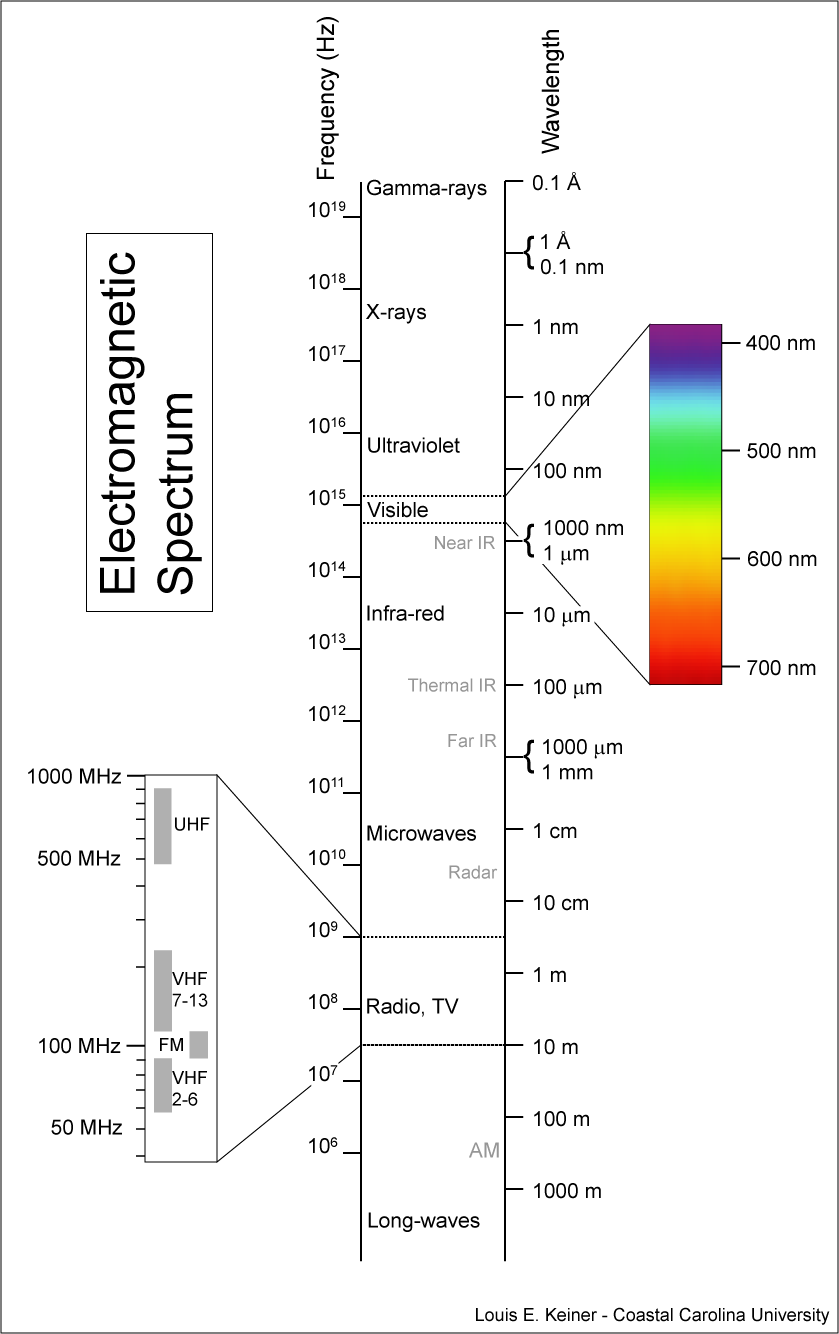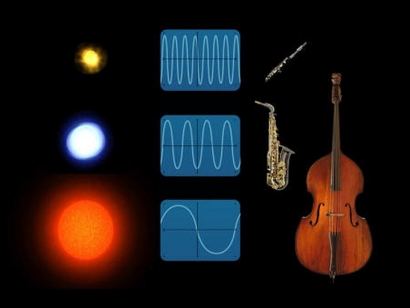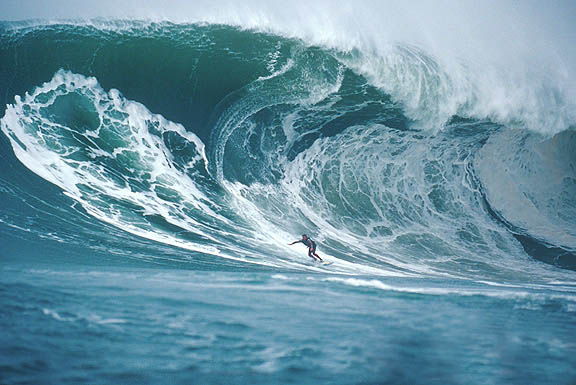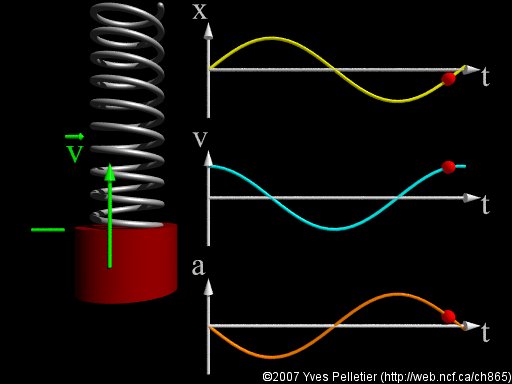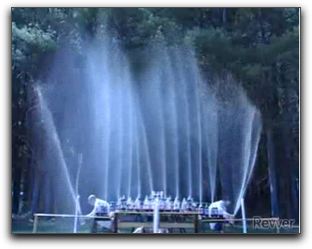This page contains all class handouts and other items of interest for students of Physics 5B at the University of California, Santa Cruz.
Results of the final exam and course grades
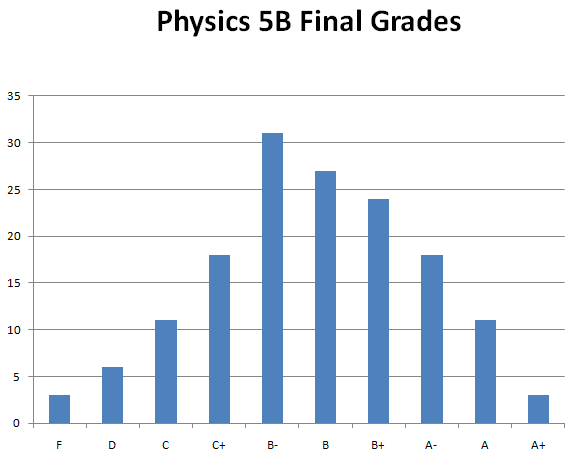 Letter grades are based on the cumulative course average, which
is weighted according to: class participation (clickers)---5%;
homework (10 problem sets with the low score dropped)---20%;
first midterm exam---20%; second first midterm exam---20%; and
the final exam---35%. This cumulative course average is then
converted into a letter grade according to the following ranges:
A+ (83--100); A (77.5--83); A- (72--77.5); B+ (66--72); B (60--66);
B- (54--60); C+ (48--54); C(42--48); D(36--42); F (0--36).
Here is the statistical summary of the distribution of
the cumulative course averages:
Letter grades are based on the cumulative course average, which
is weighted according to: class participation (clickers)---5%;
homework (10 problem sets with the low score dropped)---20%;
first midterm exam---20%; second first midterm exam---20%; and
the final exam---35%. This cumulative course average is then
converted into a letter grade according to the following ranges:
A+ (83--100); A (77.5--83); A- (72--77.5); B+ (66--72); B (60--66);
B- (54--60); C+ (48--54); C(42--48); D(36--42); F (0--36).
Here is the statistical summary of the distribution of
the cumulative course averages: mean: 61.0 median: 61.7 high: 87.1 low : 13.1
Solutions to the final exam can now be found at
Section V of this website.
Graded exams can be picked up in my office starting starting on
Monday March 23. Here are the relevant exam statistics.
First, a histogram of the test scores is shown below:
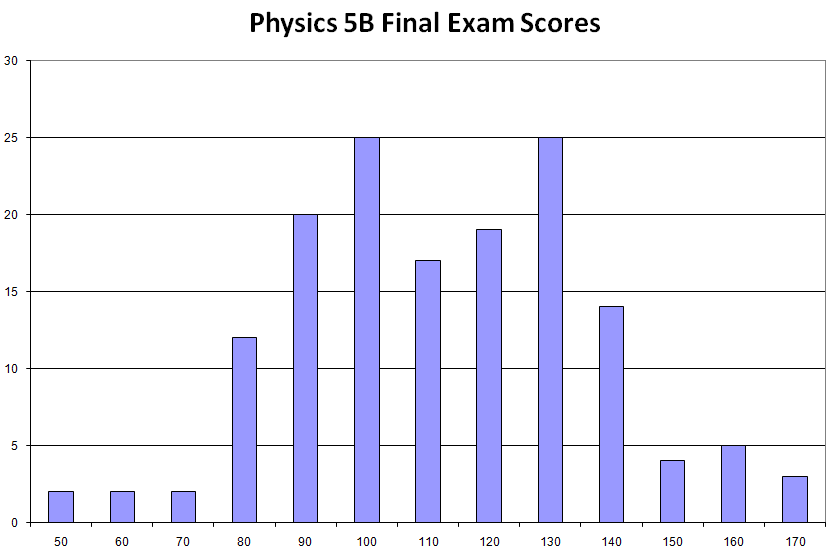
Horizontal axis labels correspond to the upper value of a bin
which is 10 grades points wide. For example, the 170 label refers to grades
from 161--170, the 160 label refers to grades from 151--160, etc. The total
number of points available was 175. Here is the
final exam statistical summary:
exam mean: 107
exam median: 108
highest grade: 167
lowest nonzero grade: 45
Approximate grade equivalents of the test scores: A+ (163--175); A (149--162);
A- (135--148); B+ (121--134); B (107--120); B- (93--106); C+ (79--92);
C(65--78); D(51--64), F (0--50). Keep in mind that the grade equivalents apply
only to this exam, and take into account the distribution of
final exam scores.
SPECIAL ANNOUNCEMENTS
A link to the Large Hadron Rap (the video shown at the end of the last class) can be found at Section X of this website.
This web page will be kept live until the fall of 2009. Password protected material can still be accessed with the same username and password used during the winter quarter.
Have a great spring break---you earned it!!!
Physics 5B: Introduction to Physics II
I. General Information and Schedule of Lectures, Sections and Tutorials
The general course information handout is available in either
PDF or Postscript format [PDF
| Postscript]
Some of the information in this handout is reproduced below.
Class Lectures, Discussion Sections and Drop-In Tutoring
Lectures [Howard Haber--Physics 5B Professor]:
-
Mondays, Wednesdays and Fridays, 9:30--10:40 am, Thimann Lecture Hall 3
TA Discussion Sections [located in ISB 235]:
- Mondays, 12:10--1:40 pm Glenn Gray
- Tuesdays, 1:45--3:15 pm Ian Carbone
- Tuesdays, 6:30--8:00 pm Auditya Sharma
In addition to TA support, additional class
learning support is available through Modified Supplemental
Instruction (MSI).
MSI Drop-In Tutoring [Taylor Griffin--tutor]:
- Mondays, 11:00 am--12:10 pm ARCenter 202
- Mondays, 7:00--8:10 pm ARCenter 202
- Thursdays, 6:30--7:45 pm Social Sciences II 137
Physics 5J Honors Section
Physics 5J is an optional two-unit course running in parallel with Physics 5B. David Smith is the instructor for this course. This course will cover more advanced treatments of some of the Physics 5B course material, along with some special topics connected to the physics of fluids, waves and optics. You can find the syllabus for Physics 5J here. The Honors Section includes additional assignments beyond those required for Physics 5B.
Honor Section [located in ISB 231]:
- Thursdays, 2:00--3:45 pm David Smith
Required Textbook
Physics for Scientists and Engineers with Modern Physics (4th edition), Volumes I and II, by Douglas C. Giancoli
Course and Exam Lecture Schedule and Assigned Readings
A detailed course lecture and exam schedule (including assigned readings)
is available in either PDF or Postscript format:
[PDF | Postscript]
A snapshot of the course lecture schedule appears below.
Brief Course Outline for Physics 5B |
||
|---|---|---|
| TOPIC | Lectures dates | Readings |
| Fluids | Jan 7, 9, 12, 14 | Giancoli, Chapter 13 | Oscillations | Jan 16, 21, 23 | Giancoli, Chapter 14 | Wave Motion | Jan 26, 28, Feb 2 | Giancoli, Chapter 15 | Sound | Feb 4, 6, 9 | Giancoli, Chapter 16 | The electromagnetic spectrum and the velocity of light | Feb 11 | Giancoli, Chapter 31, sections 6 and 7 | Light: Reflection and Refraction | Feb 11, 13, 18 | Giancoli, Chapter 32 | Lenses and Optical Instruments | Feb 20, 23, 25 | Giancoli, Chapter 33 | The Wave Nature of Light; Interference | March 2, 4 | Giancoli, Chapter 34 | Diffraction and Polarization | March 6, 9, 11, 13 | Giancoli, Chapter 35 | Final lecture and bonus material | March 16 | --- |
There are no classes on January 19 (Martin Luther King Jr. Day) and February 16 (Presidents' Day). A course review is planned for March 16, the last day of class. There will be two midterm exams and one final exam:
- Friday January 30, 9:30--10:40 am Midterm exam #1
- Friday February 27, 9:30--10:40 am Midterm exam #2
- Thursday March 19, 8:00--11:00 am Final exam
Course Grading and Requirements
5% Class participation (clickers)
20% Weekly Homework (10 problem sets)
20% First Midterm Exam
20% Second Midterm Exam
35% Final Exam
Solving problems is an integral and essential part of learning physics. Weekly homework assignments will be handed out each Wednesday and are due at the beginning of class on the Wednesday of the following week. (Exception: the last homework set will be due on the last day of class, which is a Monday.) The homework problem sets are NOT optional. You are encouraged to discuss the class material and homework problems with your classmates and to work in groups, but all submitted problems should represent your own work and understanding. In order that homework can be graded efficiently and returned quickly, late homework WILL NOT be accepted (except for special circumstances, if you have made arrangements with me prior to the due date). However, note that the lowest homework set grade will be dropped in evaluating your course grade. Your homework sets will be graded based on the clarity of your method of solution as well as on your final answers.
The two midterm exams and final exams will be held in the same classroom as the lectures. Each midterm will be a one hour and ten minute exam. The final exam will be three hours long and cover the complete course material. You must take the midterm and final exams to pass the course. You will be permitted to consult a page of personal notes during the exams.
II. Physics 5M: Introduction to Physics Laboratory II
The Physics 5M Laboratory website can be found here.
Required Laboratory Manual
Oscillations, Fluids, Waves and Optics, developed by George Brown
Laboratory sections and schedule
Laboratory Sections [George Brown--Physics 5M Professor]:
- Tuesdays, 8:30--11:30 am [Auditya Sharma--Lab TA]
- Tuesdays, 12:00--3:00 pm [Auditya Sharma--Lab TA]
- Tuesdays, 3:30--6:30 pm [Ian Carbone--Lab TA]
- Tuesdays, 7--10 pm [Glenn Gray--Lab TA]
- Wednesdays, 3:30--6:30 pm [Laura Daniel--Lab TA]
- Wednesdays, 7--10 pm [Ian Carbone--Lab TA]
- Thursdays, 12:00--3:00 pm [Laura Daniel--Lab TA]
- Thursdays, 7--10 pm [Glenn Gray-- Lab TA]
Laboratories are located in Thimann 115. The Physics 5M Laboratory schedule is listed below:
- Jan 6--8 no labs scheduled this week
- Jan 13--15 Fluids (Archimedes principle, Bernoulli's Principle)
- Jan 20--22 Harmonic Oscillator (Transient and forced oscillator response)
- Jan 27--29 Mechanical Waves (Pulses, traveling waves, standing waves, boundary conditions
- Feb 3--5 Standing Waves on a Guitar String (Harmonics)
- Feb 10--12 The Resonance Tube (Physics of the open and closed organ pipe)
- Feb 17--19 Geometric Optics (Index of refraction; single lens instruments)
- Feb 24--26 Compound Optical Systems (Newtonian telescope; microscope)
- March 3--5 Interference Phenomena (Single slit, double slit, grating)
- March 10--12 Polarization of Light
Policy for missed labs
You are required to complete every laboratory. If you know well in advance that you will not be able to attend a lab, then you must get the written agreement of your regular TA and the TA of the section that you want to attend before you show up to that section. Please note that you will not be admitted to a lab section that already has 22 students enrolled, which is a strict upper limit.
If you miss one laboratory without approval in advance, your final grade will be marked down by one full letter. If you miss two labs, you will not pass the course. Because of logistical constraints, there will be no makeup labs.
III. Homework Problem Sets and Exams
Problem sets and exams are available in either PDF or Postscript formats. Graded homeworks will be returned to the Physics 5B boxes located adjacent to Thimann 111D (near the Physics 5B laboratories).
- Homework Set #1--due: Wednesday January 14, 2009 [PDF | Postscript]
- Homework Set #2--due: Wednesday January 21, 2009 [PDF | Postscript]
- Homework Set #3--due: Wednesday January 28, 2009 [PDF | Postscript]
- MIDTERM EXAM #1-- Friday January 30, 2009 [PDF | Postscript]
- Homework Set #4--due: Wednesday February 4, 2009 [PDF | Postscript]
- Homework Set #5--due: Wednesday February 11, 2009 [PDF | Postscript]
- Homework Set #6--due: Wednesday February 18, 2009 [PDF | Postscript]
- Homework Set #7--due: Wednesday February 25, 2009 [PDF | Postscript]
- MIDTERM EXAM #2-- Friday February 27, 2009 [PDF | Postscript]
- Homework Set #8--due: Wednesday March 4, 2009 [PDF | Postscript]
- Homework Set #9--due: Wednesday March 11, 2009 [PDF | Postscript]
- Homework Set #10--due: Monday March 16, 2009 [PDF | Postscript]
- FINAL EXAM--Thursday March 19, 2009 [PDF | Postscript]
IV. Practice Problems for the Midterm and Final Exams
Practice midterm and final exams can be found here. These should give you some idea as to the format and level of difficulty of the exam.
To access the solutions to the practice exams, you will need to use the same username (Physics5B) and password that you use to access the homework solutions. The username and password are case sensitive.
- Practice Midterm Exam I-A [PDF | Postscript] and the solutions [PDF | Postscript]
- Practice Midterm Exam I-B [PDF | Postscript] and the solutions [PDF | Postscript]
- Practice Midterm Exam II-A [PDF | Postscript] and the solutions [PDF | Postscript]
- Practice Midterm Exam II-B [PDF | Postscript] and the solutions [PDF | Postscript]
- Practice Final Exam A [PDF | Postscript] and the solutions [PDF | Postscript]
- Practice Final Exam B [PDF | Postscript] and the solutions [PDF | Postscript]
V. Solutions to Homework Problem Sets and Exams
The homework set and exam solutions are available in PDF format. Solutions will be posted shortly after the homework is due and after the exams have been completed. To view the solutions, you will need a username and password, since much of this material is copyrighted The username is Physics5B (it is case sensitive) and the password (also case sensitive) has been announced in class. If you don't have the password, ask one of the other Physics 5B students or send me e-mail.
- Solutions to Homework Set #1 [PDF]
- Solutions to Homework Set #2 [PDF]
- Solutions to Homework Set #3 [PDF]
- Solutions to MIDTERM EXAM #1 [PDF | Postscript] [exam statistics]
- Solutions to Homework Set #4 [PDF]
- Solutions to Homework Set #5 [PDF]
- Solutions to Homework Set #6 [PDF]
- Solutions to Homework Set #7 [PDF]
- Solutions to MIDTERM EXAM #2 [PDF | Postscript] [exam statistics]
- Solutions to Homework Set #8 [PDF]
- Solutions to Homework Set #9 [PDF]
- Solutions to Homework Set #10 [PDF]
- Solutions to the FINAL EXAM [PDF | Postscript] [exam statistics]
VI. Clicker questions
If you still have not yet registered your clicker for Physics 5B,
you should click on the following
link
to complete the
registration. When the webpage
comes up, you should click on the
button that says Click to Register.
Some of the material below is copyrighted, and hence password protected. Use the same username and password that you use to access homework and exam solutions.
-
Show how it is possible to determine the height
of a tall building with the aid of a barometer.
Possible answers are shown here.
A more complete treatment of this problem and a link to the
history
of this question can be found
here.
- Consider a tank of liquid whose top is open to the atmosphere.
The level of the liquid is a distance h from the bottom of the tank,
which is at ground level.
Three spouts on the side of the tank are placed at heights h/4,
h/2 and 3h/4 above the ground. Fluid shoots out of each spout and
each fluid stream eventually reaches the ground. Four possible
sketches are shown displaying where the three fluid streams reach the
ground (click here to see the figure).
Which sketch is the most accurate (assuming all trajectories shown are
parabolic in shape)?
-
Which weighs more: (a) one gallon of water; (b) one gallon of crude
oil; (c) one gallon of vegetable oil; or (d) they all weigh the same?
For the answer, check out this link.
-
Two connected balloons,
inflated to different sizes, are connected by
a short clear plastic tube as shown
here.
A connecting valve (which controls the
possible flow of air between the two balloons) is initially closed.
If the connecting valve is now opened allowing air to flow between the
two balloons, which of the following occurs: (a) Nothing happens,
and both balloons remain in their initial state; (b) The smaller
balloon contracts, forcing air inside the larger one; (c) The larger
balloon contracts, forcing air inside the smaller one. When the final
state is reached, both balloons are equally inflated (i.e. the same size);
or (d) The larger balloon contracts, forcing air inside the smaller one.
When the size of the larger balloon is equal to the original size of
the smaller balloon, the process reverses and returns to the original
initial state. The cycle then starts again. The answer is
illustrated here.
-
A hole is drilled through the center of Earth and emerges on the other
side. You jump into the hole. What happens to you?
(a) you fall to the center and stop;
(b) you go all the way through and continue off into space;
(c) you fall to the other side of Earth and then return; or
(d) you will not fall at all.
For the incorrect answer (according to
Pearls Before Swine)
click here.
For the correct answer,
click here.
-
Consider a traveling wave on a string, where the wave is moving to the right.
Focus on a point on the string located at the crest of the wave.
The direction of velocity of a particle of the string at this point
is: (a) to the right; (b) pointing 45° to the right and downward;
(c) downward; (d) upward; (c) the velocity is zero.
Click here for the answer.
- Now, answer clicker question #3 for a particle on the string located
equidistant between the crest just considered and the following
trough (same five choices as before).
Click here for the answer.
-
A length of rope L and mass M hangs from a
ceiling. If the bottom of the rope is jerked sharply, a wave pulse
will travel up the rope. As the wave travels upward, does the speed of the
pulse (a) increase; (b) remain constant; or (c) decrease?
Click here for the answer.
-
An initially horizontal
string is clamped at both ends and plucked so that it vibrates in a
standing mode. At one point in the vibration cycle, the
position of the string coincides with its equilibrium position (in
which the string is completely horizontal). If we define upward
motion to correspond to positive velocity, when the string is
horizontal, the instantaneous velocity of points on the string:
(a) is zero everywhere; (b) is positive everywhere; (c) is negative
everywhere; or (d) depends on the position along the string.
Click here for the answer.
-
Two friends are having a conversation. The intensity of the sound
from each person speaking separately is 60 dB. At some point the
conversation becomes heated, and the two friends speak simultaneously
(without raising their voices). The intensity of the combined sounds
of their speaking voices is: (a) 60 dB; (b) 62 dB; (c) 63 dB; (d) 70 dB;
or (e) 120 dB. Click
here for the answer.
-
You hold a hand mirror 0.5 m in front of you and look at your
reflection in a full-length mirror 1 m behind you. How far in back of
the big mirror do you see the image of your face: (a) 0.5 m;
(b) 1.0 m; (c) 1.5 m; (d) 2.0 m; (e) 2.5 m?
Click here for the answer.
-
A light ray propagates from medium 1 to medium 2 to medium 3, as shown
in this figure. The
corresponding indices of refraction are n1,
n2, and n3, respectively. Determine the relative
magnitudes of the indices of refraction---do they satisfy:
(a) n1 > n2 > n3;
(b) n3 > n2 > n1;
(c) n2 > n3 > n1;
(d) n1 > n3 > n2; or
(e) none of the above. Click
here for the answer.
-
To shoot a fish with a gun (assume the gun shoots real bullets),
as shown in this figure
should you: (a) aim directly at the image:
(b) aim slightly above the image; or (c) aim slightly below the image?
You may ignore the effects on the bullet due to gravity. Click
here for the answer.
How would your answer to this question change if you were to use a laser gun [as shown in this figure]? Click here for the answer.
-
A lens is used to image an object onto a screen. if the right half of
the lens is covered, which one of the following statements is correct?
(a) The left half of the image disappears; (b) the right half of the
image disappear; (c) the entire image disappears; (d) the image
becomes blurred; or (e) the image becomes fainter. Click
here for the answer.
-
Consider two identical microscopic slides in air illuminated with
light from a laser, similar to the wedge shown in Figure 34-20a of Giancoli.
The bottom slide is rotated upward so that the wedge angle gets a bit
smaller. As a result, the interference fringes are (a) spaced further
apart; (b) spaced closer together; or (c) are unchanged in their
spacing. Click here for
the answer.
-
Consider two identical microscopic slides in air illuminated with
light from a laser, similar to the wedge shown in Figure 34-20a of Giancoli.
The space between the slides (where the air initially resides) is
now filled with water (n=4/3).
As a result, the interference fringes are (a) spaced further
apart; (b) spaced closer together; or (c) are unchanged in their
spacing. Click here for
the answer.
-
Consider a diffraction pattern that arises from a single
slit. If one wishes to sharpen the pattern, i.e. make the central
bright spot narrower, what should be do to the slit width?
(a) narrow the slit; (b) widen the slit; (c) enlarge the screen; or
(d) close off the slit. Click
here for the answer.
-
Blue light of wavelength λ passes through a single slit of
with d and forms a diffraction pattern on a screen.
If the blue light is replaced by red light of wavelength
2λ, the original diffraction pattern can be reproduced if the
slit width is changed to: (a) d/4; (b) d/2;
(c) no change needed; (d) 2d; (a) 4d. Click
here for the answer.
-
Consider three polarizers called H, V and D. The transmission
axes of the polarizers
H, V and D are horizontal, vertical and diagonal at
45o, respectively. Unpolarized light is incident from the
left on the three polarizers, which appear in some
order as depicted here .
Consider three possible cases for the order of the polarizers
(from left to right): (1) H, V, D; (2) H, D, V; (3) D, H, V. In which
cases does some light get through? (a) only case 1; (b) only case 2;
(c) only case 3; (d) cases 1 and 3; (e) all three cases. Click
here for the answer.
-
Consider a coherent source of light shining on Young's two-slit
interference experiment. Assume that each slit size is much smaller
than the separation of the two slits.
First, note the pattern of fringes on the
screen behind the slits. Suppose we now cover each of the two slits
with a linear polarizer such that the direction of polarization of the
light transmitted by the two slits are perpendicular. Then, on the
screen behind the slits:
(a) the pattern of fringes is unchanged;
(b) the pattern of fringes changes such that the intensity maxima
occur where the minima used to be;
(c) no light is seen at all on the screen; or
(d) a fairly uniformly illuminated
elongated spot is seen on the screen. Click
here for the answer.
VII. Other Class Handouts
1. A nice treatment of surface tension can be found here. This article is an excerpt from Essentials of Physics, by John D. Cutnell and Kenneth W. Johnson (Wiley Publishing, 2006).
2. These notes provide details on how to solve the equations of motion of the simple harmonic oscillator. The connection between the initial conditions (i.e. the initial displacement and velocity of the oscillator) and the amplitude and phase of oscillations is elucidated. [PDF | Postscript].
3. The derivation of the solution to the equation of motion for a forced oscillation, which is given in Eqs. (14-22) to (14-24) of Giancoli is relegated to the problems. I provide Giancoli's derivation in this handout [PDF].
4. Giancoli's derivation of the time-averaged power and intensity of transverse waves propagating along a string is hand-waving at best. I have prepared some notes, entitled Rate of Energy Transfer by Sinusoidal Waves on a String, which provides a more careful treatment of the energy transport by one-dimensional transverse waves along a string. [PDF | Postscript].
5. Parallel rays that reflect off a spherical mirror do not meet at a unique focal point, if the angle of incidence is not too small. In contrast, parallel rays that propagate parallel to the symmetry axis of a parabolic mirror will meet at a unique focal point after reflection. Details can be found in the following class handout. [PDF | Postscript].
6. Fermat's principle states that "light travels between two points along the path that requires the least time, as compared to other nearby paths." From Fermat's principle, one can derive the law of reflection (the angle of incidence is equal to the angle of reflection) and the law of refraction (Snell's law). Details can be found in the following class handout. [PDF]. This is problem 81 on page 864 of Giancoli.
7. Sign conventions for mirrors, refracting surfaces and lenses. By carefully abiding by a set of sign conventions, the mirror and thin lens equations can be used in all circumstances. This handout summarizes all the sign conventions used for mirrors, refracting surfaces and lenses. : for lenses, the sign convention for the radius of curvature of the back surface of the lens (R2) employed by this handout differs by an overall sign from the sign convention of Giancoli. As this handout is copyrighted material (taken from Physics for Scientists and Engineers (7th edition) by Raymond A. Serway and John W. Jewett, Jr.), you will need a password to access it.
8. Lateral magnification of an image formed by refraction at a spherical surface. Although Giancoli provides a formula for determining the location of an image formed by refraction at a spherical surface [cf. Eq. 32-8], he does not compute the lateral magnification of the image. To correct this deficiency, I provide a derivation of the lateral magnification of an image formed by refraction at a spherical surface in the following class handout. [PDF | Postscript].
9. A comparison of the normal eye, the myopic eye (unaided and corrected) and the hyperopic eye (unaided and corrected), taken from Introduction to Optics (3rd Edition), by Frank L. Pedrotti, Leno M. Pedrotti, and Leno S. Pedrotti, is reprinted in the following class handout [PDF]. In these figures, N.P. is the near point (which is 25 cm for the normal eye), F.P. is the far point (which is equal to infinity for the normal eye), M.N.P. and M.F.P. are the myopic near and far points, respectively, and H.N.P. is the hyperopic near point. In the myopic and hyperopic case, N.N.P. denotes the location of the "normal near point" of 25 cm. As this handout is copyrighted material, you will need a password to access it.
10. In Section 34-4 of Giancoli, the intensity in the double-slit interference pattern is computed. However, only some of the mathematical details are shown. I provide a detailed derivation of the sum of two sinusoidal functions of differing amplitudes and phases in the following class handout. [PDF | Postscript]. This handout also includes a discussion of the method of phasors.
11. In Giancoli, section 35-2, a derivation of the intensity of the light due to single slit diffraction is provided using the technique of phasor diagrams. In this class handout, I fill in some of the details omitted from Giancoli's derivation. [PDF | Postscript] In addition, this handout provides a derivation of the same result, by converting the sum of N sine functions in the limit of N → ∞ to an elementary integral that is easily computed. For fun, I have also included an alternative derivation of the same result, which makes use of an explicit summation of the N sine functions (before taking the limit). The derivation of this sum is beyond the scope of this class, but I present the details in an appendix for completeness.
VIII. Articles of Interest
1. A detailed experimental study of the diet coke and mentos reaction and some of its implications has been published recently in the American Journal of Physics 76, 551--557 (2008) [ Abstract | HTML ].
2. How is water transported from the roots to the top leaves of a tall redwood tree? A very readable account by N. Michele Holbrook and Maciej A. Zwieniecki entitled Transporting water to the top of trees, published in Physics Today, volume 61 [January, 2008] pages 76--77, describes the most recent scientific understanding of this phenomenon [ HTML | PDF ].Another nice treatment of this topic can be found in a short article by Melvin T. Tyree, published in Nature, volume 423 [26 June 2003] page 923.
Have a look at these two articles to see what roles the surface tension of water and capillarity play in the transportation of water from the ground to the to top leaves of a tree.
IX. Applets for Physics 5B
Here are some physics java applets that allow you to explore some of the physics concepts covered in Physics 5B.
1. Buoyant Force. Study the properties of buoyancy with this applet.
2. Lissajous Figures. This applet displays the trajectory of two independent harmonic oscillators (one in the x-direction and one in the y-direction). The relative phase and the amplitudes of the two oscillators can be adjusted.
3. The forced harmonic oscillator applet. Explore the properties of a forced harmonic oscillator and resonance phenomena. Damping effects are included. If you are interested simply in the properties of the damped harmonic oscillator (with no external applied force, try the damped harmonic oscillator applet).
4. Transverse Waves - reflection and transmission. Explore the reflection and transmission of a transverse pulse propagating along a string, for various boundary conditions at the end.
5. Beats. Explore what happens when you superpose two waves of the same amplitude but slightly different frequencies. Watch the waveform change as you change the difference of the two frequencies. Another applet that includes sound, so that you can hear how the beats change by modifying the frequency difference can be found here.
6. The Doppler Effect. Here you can visualize the Doppler effect. It's easy: Just click anywhere within the gray area of the applet and drag the mouse. An arrow representing the source velocity vector will appear. The speed of the source divided by the sound speed (called the Mach number) is also displayed numerically. Let go of the mouse, and your source will move across the screen, emitting waves.
7. Spherical mirrors and lenses. Explore the properties of spherical mirrors and lenses, by varying the focal length, object distance, magnification, and the shape of the mirror or lens.
8. Reflection and Refraction of Waves as explained by Huygens' Principle. This applet is a sort of tutorial which explains the reflection and the refraction of waves by the principle of Huygens. Explanations of each of the steps are provided in the text box.
9. Ripple tank simulation. This java applet is a simulation of a ripple tank. It demonstrates waves in two dimensions, including such wave phenomena as interference, diffraction (single slit, double slit, etc.), refraction, resonance, phased arrays, and the Doppler effect.
10. A related applet to the ripple tank simulation is the 2-D Wave simulation. This java applet is a simulation that demonstrates scalar waves (such as sound waves) in two dimensions. It demonstrates the wave principles behind slit diffraction, zone plates, and holograms.
11. N-slit diffraction. This applet allows you to explore the interference pattern due to light passing through N narrow slits. You can vary N and also include or exclude the effects of single-slit diffraction. A similar applet that illustrates two-slit interference with diffraction is also quite nice. An applet that focuses entirely on the interference pattern due to single slit diffraction is also quite illuminating (excuse the pun!).
12.Young's Two-Slit Experiment with Laser light. Similar to the applets above, but with very nice graphics. Suppose that you replace the laser light with a beam of electrons. What do you think will happen? For a surprise, have a look at this webpage from the Physics 2000 website.
13. Polarizers. Explore the the polarization of light by playing with up to three polarizers in this simulation of an optical bench.
X. Web pages of Interest
1. The Diet Coke and Mentos experiment. A history of the experiment and a short discussion of the underlying physics principles can be found on Wikipedia. A video demonstration of the experiment can be found here.
2. Which weighs more: (a) one gallon of water; (b) one gallon of crude oil; (c) one gallon of vegetable oil; or (d) they all weigh the same? This question decided the grand prize of $1,795,000 for one contestant on the final round of the ABC game show "Duel", televised on December 23, 2007. If only Robert, the used car salesman, had learned his Physics 5B better....
3. Sulfur hexafluoride (SF6) is a transparent (colorless), odorless, non-toxic and non-flammable gas, which is about 5.1 times denser than air (at standard temperature and pressure). Consequently, one can fill up a water tank with sulfur hexafluoride and float a light boat on its surface. It looks like the boat is floating on nothing! Check out the video taken at the Physics Show, a biannual event hosted by the Physics Department of the University of Bonn in Germany.4. Animated Demonstration of Bernoulli's Principle. The Bernoulli's Principle animation on this webpage explores the behavior of an ideal fluid passing through a pipe. You can interact with the animation, and immediately see the effects on the fluid velocity and pressure. The animation is accompanied by two discussions - an introductory discussion without any math, and a more advanced discussion involving algebra and calculus.
5. The longest continuously running laboratory experiment has been running since 1927. The goal of this experiment is to measure the viscosity of pitch. So far eight drops have fallen in the last 82 years, suggesting that the viscosity of pitch is approximately 100 billion times that of water. A brief survey of this experiment and additional references can be found in Wikipedia.
In fact, this is not a record for the largest recorded viscosity. Larger viscosities have been measured for some glasses at high temperatures. A plot of the viscosities of a variety of different glasses as a function of temperature can be found here. Note that the units of viscosity given in the plot are dPa⋅s (d means "deci" so 1 dPa=0.1 Pa). In these units, water at T=20°C has a viscosity of 0.01 dPa⋅s. Note that the curves correspond to a temperature range that is way above room temperature. The viscosity of glass at room temperature cannot be measured, as it is too high. Theoretical calculations suggesting a viscosity as large as 1019 Pa⋅s have appeared in the literature!
6. Foucault's pendulum is a dramatic demonstration of the rotation of the earth. An animation of this effect demonstrates how the plane of the pendulum is seen to rotate by an observer on earth (which is a rotating reference frame). Foucault first demonstrated the effect in 1851 under the great dome of the Pantheon in Paris, using a 28 kg weight on a wire suspension nearly 70 m long. The attachment of the upper end of the wire allows the pendulum to swing with equal freedom in any direction. One can still see Foucault's pendulum in action at the Pantheon (presumably not the original one)---check out this short film. A slightly more interesting film exhibiting Foucault's pendulum can be found here.
7. The Tacoma Narrows Bridge Collapse. On November 7, 1940, the Tacoma Narrows Bridge, just over four months after its opening, sustained gale winds that incited a torsional vibrational resonance mode. The bridge collapsed within a few hours, and provided many future physics classes with a dramatic depiction of a resonance phenomenon.
8. Fourier series for a square wave. A periodic square wave with period T can be very well approximated as a superposition of sinusoidal waves of frequencies nf1 with corresponding amplitudes An ∝ 1/n, for n=1,3,5,.... and f1=1/T. This video provides a dramatic demonstration of this result by employing the superposition of sound tones of the appropriate frequencies and amplitudes.
9. Reflection of Waves from Boundaries. The animations exhibited here demonstrate the reflection and transmission of a transverse pulse on a string as it approaches various types of boundaries.
10. 'Hard Day's Night': A Mathematical Mystery Tour. The jangly opening chord of The Beatles' hit "A Hard Day's Night" is one of the most recognizable in pop music. Maybe it sounds like nothing more than a guitarist telling his bandmates, "Hey, we're doing a song here, so listen up." But for decades, guitarists have puzzled over exactly how that chord was played. On NPR's Weekend Edition (Saturday, December 27, 2008), the mystery of that opening chord is revealed.
11. Why does a sound wave propagating down a thin cylindrical tube reflect off an open end of the tube? Although the reflection is not 100%, most of the wave is reflected back up the tube. This allows for a standing wave to form in the tube (such that the acoustic pressure at the open end vanishes). An animation of the behavior of an acoustic pressure pulse that encounters either an open or closed end of a cylindrical tube can be found here. Another simple explanation of the physics underlying the reflection of sound waves off of an open end and closed end of a cylindrical tube is provided by N. Drozdoff.
12. For an amusing look at the electromagnetic spectrum, check out this image, courtesy of google images, taken from imgs.xkcd.com/comics. A more standard depiction of the electromagnetic spectrum can be found here: [PDF]. By the way, when the switch is made to digital TV, nearly all digital channels will be located in the UHF range of the electromagnetic spectrum (while a few will occupy the VHF range).
13. Relevant to our study of mirrors and their properties, I have selected a famous lithograph by M.C. Escher (see the reproduced image on the left-hand side of this webpage) as a symbol for the lectures based on the material of Chapter 32 of Giancoli. For more information on Escher and his work, check out the official Escher website; many of his works can be viewed from the "Picture Gallery" link on that webpage. For example, you can find in the picture gallery Escher's, Magic Mirror, a close second choice for the image of the week. Another website with many Escher prints for viewing can be found here.
14. A web page entitled Optics and Visual Perception provides numerous links to topics in physical optics and physiological optics. Elsewhere on this website you can find an illuminating article on the physics of the rainbow.
15. Large Hadron Rap. In October, 2009, the Large Hadron Collider (LHC) will begin colliding very high energy beams of protons together (each initially at five trillion electron volts of equivalent energy), in order to probe the shortest distance scales ever studied. The LHC straddles the French-Swiss border near Geneva, Switzerland, and measures 27 km in circumference. Check out this video to learn what particle physicists hope to discover at the LHC.
haber@scipp.ucsc.edu
Last Updated: April 30, 2009

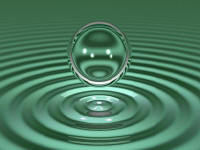
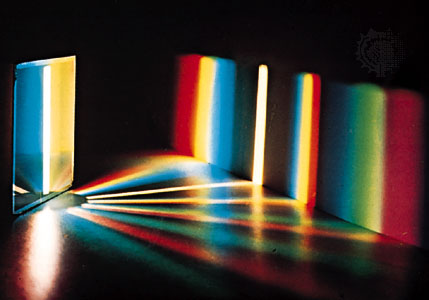
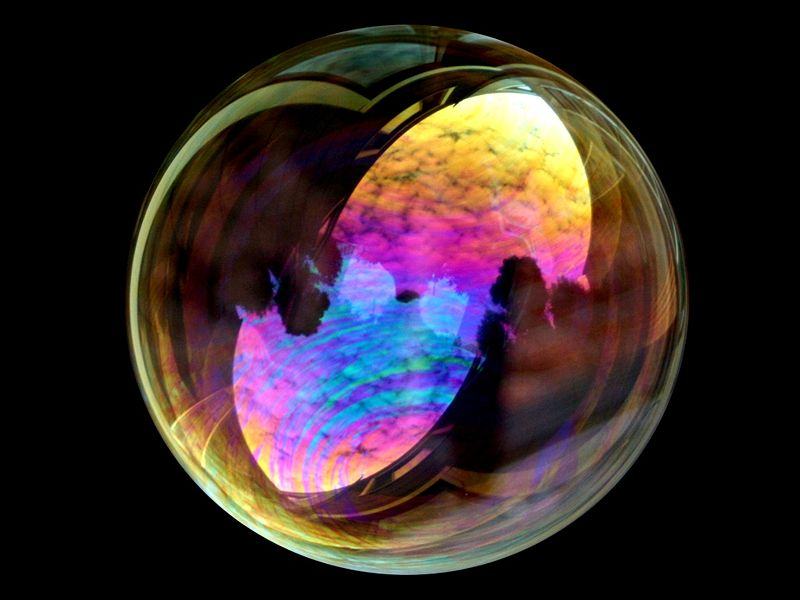
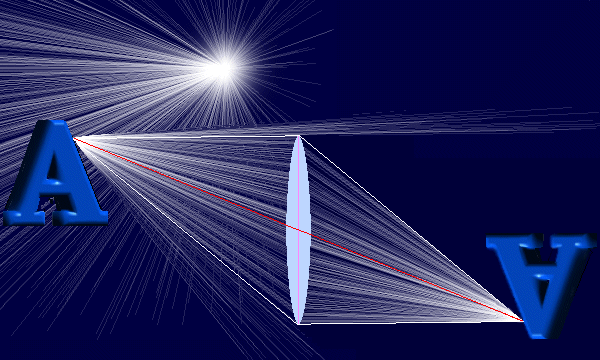
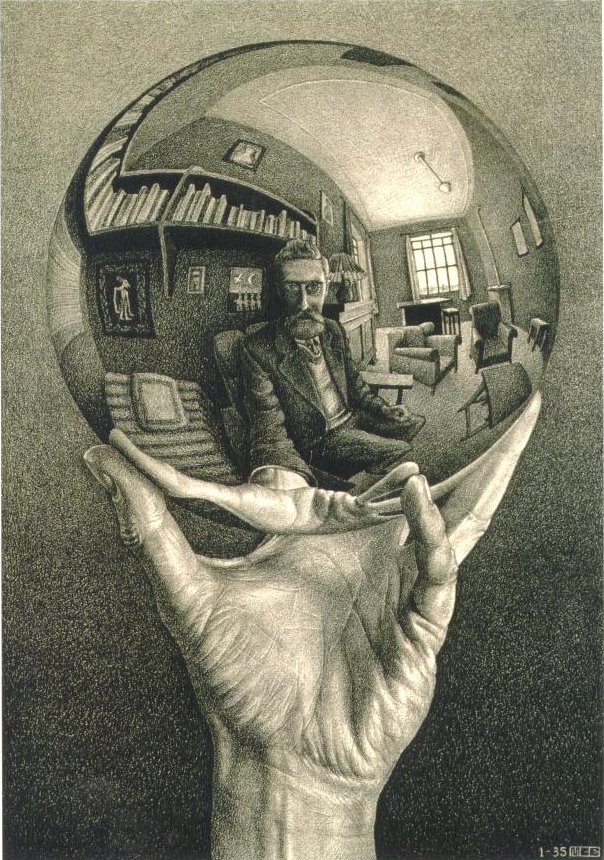 Hand with Reflecting Sphere (Self-Portrait in Spherical Mirror),
by M.C. Escher
Hand with Reflecting Sphere (Self-Portrait in Spherical Mirror),
by M.C. Escher
